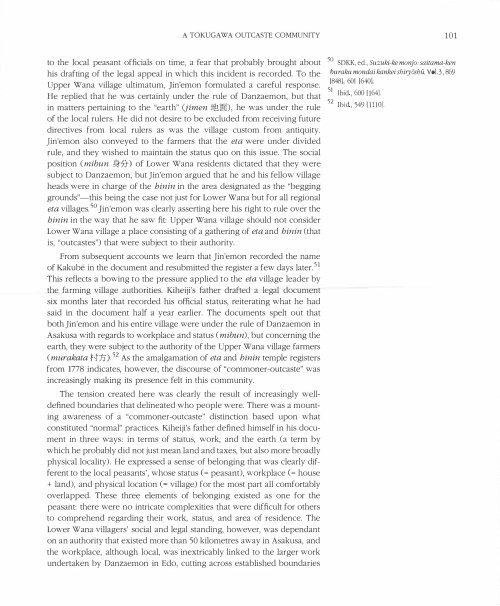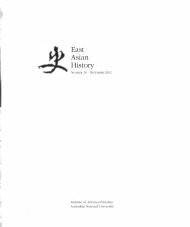Portrait of a Tokugawa Outcaste Community ... - East Asian History
Portrait of a Tokugawa Outcaste Community ... - East Asian History
Portrait of a Tokugawa Outcaste Community ... - East Asian History
Create successful ePaper yourself
Turn your PDF publications into a flip-book with our unique Google optimized e-Paper software.
A TOKUGAWA OUTCASTE COMMUNITY101to the local peasant <strong>of</strong>ficials on time, a fear that probably brought abouthis drafting <strong>of</strong> the legal appeal in which this incident is recorded. To theUpper Wana village ultimatum, ]in'emon formulated a careful response.He replied that he was certainly under the rule <strong>of</strong> Danzaemon, but thatin matters pertaining to the "earth" (jimen t{hOO) , he was under the rule<strong>of</strong> the local rulers. He did not desire to be excluded from receiving futuredirectives from local rulers as was the village custom from antiquity.]in'emon also conveyed to the farmers that the eta were under dividedrule, and they wished to maintain the status quo on this issue. The socialposition (mibun %51-) <strong>of</strong> Lower Wana residents dictated that they weresubject to Danzaemon, but ]in'emon argued that he and his fellow villageheads were in charge <strong>of</strong> the hinin in the area deSignated as the "begginggrounds"-this being the case not just for Lower Wana but for all regionaleta villages. 50 ]in'emon was clearly asserting here his right to rule over thehinin in the way that he saw fit: Upper Wana village should not considerLower Wana village a place consisting <strong>of</strong> a gathering <strong>of</strong> eta and hinin (thatis, "outcastes") that were subject to their authority.From subsequent accounts we learn that ]in'emon recorded the name<strong>of</strong> Kakube in the document and resubmitted the register a few days later. 51This reflects a bowing to the pressure applied to the eta village leader bythe farming village authorities. Kiheiji's father drafted a legal documentsix months later that recorded his <strong>of</strong>ficial status, reiterating what he hadsaid in the document half a year earlier. The documents spelt out thatboth ]in'emon and his entire village were under the rule <strong>of</strong> Danzaemon inAsakusa with regards to workplace and status (mibun), but concerning theearth, they were subject to the authority <strong>of</strong> the Upper Wana village farmers(murakata :.t17J) 52 As the amalgamation <strong>of</strong> eta and hinin temple registersfrom 1778 indicates, however, the discourse <strong>of</strong> "commoner-outcaste" wasincreasingly making its presence felt in this community.The tension created here was clearly the result <strong>of</strong> increasingly welldefinedboundaries that delineated who people were. There was a mountingawareness <strong>of</strong> a "commoner-outcaste" distinction based upon whatconstituted "normal" practices. Kiheiji's father defined himself in his documentin three ways: in terms <strong>of</strong> status, work, and the earth (a term bywhich he probably did not just mean land and taxes, but also more broadlyphysical locality). He expressed a sense <strong>of</strong> belonging that was clearly differentto the local peasants', whose status (= peasant), workplace (= house+ land), and physical location (= village) for the most part all comfortablyoverlapped. These three elements <strong>of</strong> belonging existed as one for thepeasant: there were no intricate complexities that were difficult for othersto comprehend regarding their work, status, and area <strong>of</strong> residence. TheLower Wana villagers' social and legal standing, however, was dependanton an authority that existed more than 50 kilometres away in Asakusa, andthe workplace, although local, was inextricably linked to the larger workundertaken by Danzaemon in Edo, cutting across established boundaries50 SDKK, ed., Suzuki-ke monjo: saitama-kenburaku mondai kankei shiryi5shii, YoU, 869[848], 601 [640].51 Ibid, 600 [164152 Ibid, 549 [1110].
















